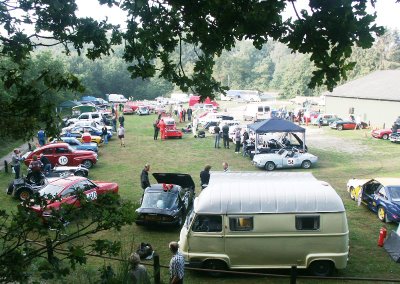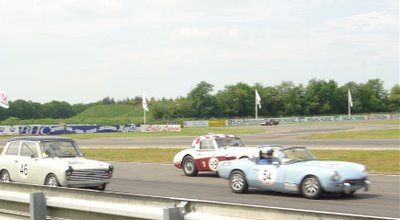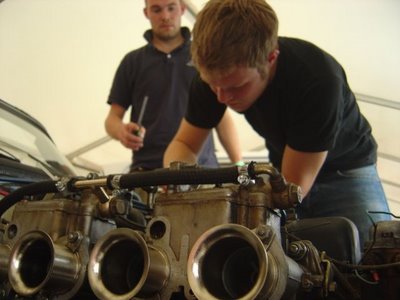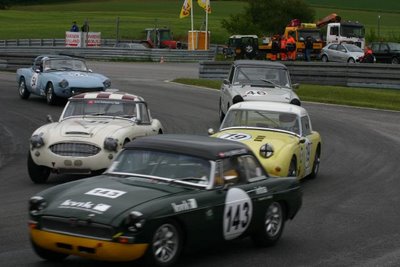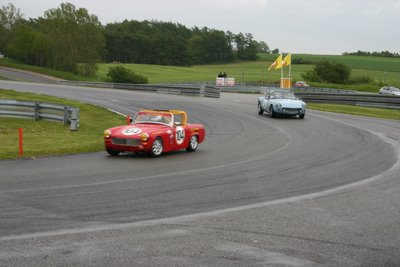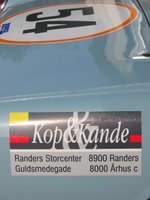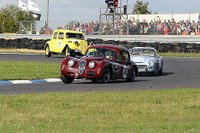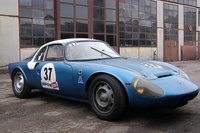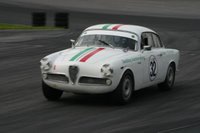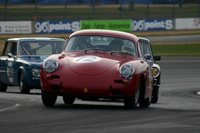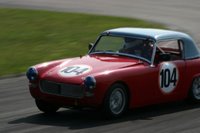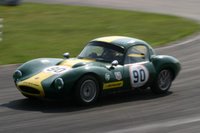The first arrangement of the season was almost in my back yard, and I owed my participation: Last year I was ready to race as well, but the head gasket blew the evening before race day. I wasn't nervous about repeating this, even though I had only driven the Spitfire about one kilometer since the overhaul of the cylinderhead (finished and torqued down the day before the race) - I had regained confidence in the car. Or maybe just found my usual optimism? Anyway, on the 30 kilometer trip to the race venue at Frijsenborg the car behaved fine - neither better nor worse than last year.
Presumably this would also mean that the speed would be comparable to last year - and would that be enough? Well, the participant's list suggested that a class win would be within possibilities - I was the only contestant in my class!
My closest sompetitor from last year, Sten Laursen in Fiat Abarth, had been moved to the class for newer cars up to 1971. I was not too happy about that, as I had been looking forward to competing with him all winter - on more than one occasion our best times last year were separated by tenths of seconds. But his car had been modified with newer features, which didn't appear u ntil 1967, so he did rightfully belong in that class. But the risk of being alone in class was not comforting, and I thought of alternatives - and would you believe it, the Spitfire is also homologated in 1966. Therefore I'd be able to run in the 1971-class as well, and meet the Fiat Abarth once again. The battle would be much harder fought here, as there were several Abarth listed as well as a very quick Sunbeam Imp - and I guess more will follow during the season. So I made a quick decision and decided to change class, into tougher company.
 And then hard work awaited! As usual we had two training runs in the morning and three timed runs in the afternoon - and the fastest two were counting. The first results from the morning clearly showed that my new competitors were quick - my best time of 1:06,5 was third-fastest, as the Abarth and the Imp had posted 1:02,9 and 1:06 respectively. So the Spitfire and I were in for a hard match. The route was very exciting - good combinations of slow and fest corners, and a very slow chikane. As I could see were to improve my time I was pretty keen after lunch, when the timed runs would start.
And then hard work awaited! As usual we had two training runs in the morning and three timed runs in the afternoon - and the fastest two were counting. The first results from the morning clearly showed that my new competitors were quick - my best time of 1:06,5 was third-fastest, as the Abarth and the Imp had posted 1:02,9 and 1:06 respectively. So the Spitfire and I were in for a hard match. The route was very exciting - good combinations of slow and fest corners, and a very slow chikane. As I could see were to improve my time I was pretty keen after lunch, when the timed runs would start.

In the first run I came away pretty good with exactly the right amount of wheelspin - but braked too early for both the first and second curve. The exit was good though, and this was important in especially the second curve, as this was followed by a long winding stretch of full power - at least in my car. I exited in second gear, and wound the engine over 7000 rpm in order to be sure to land in the powerband after the shift to third. Unfortunately the engine then misfired again - the problem that plagued me last year was apparantly still there, although not too serious this time: I immediately changed up as I felt the misfiring, and while they last year continued in the new gear this wasn't the case here, so I felt that they didn't cost me too much of a time loss. Then to the chicane, where I again braked too early, but exited quite well - as I also did in the last lefthander before crossing the line. I was pretty sure that time was much faster than the practice runs, and it was: 1:03,6 was great - and the Fiat Abarth did 1:06,2?!? That meant that I was leading my new class, so I was feeling pretty snug.
 My exitement lasted until I heard that the slow Abarth-time was due to a five second penalty for touching the chicane. Hmmm - that meant his actual time was around 1:01, so I would have to really get going in order to beat him. Enginewise the odds were bad, as I decided to stay under 6700 rpm next time to avoid the misfiring. Any time gains would have to be found elsewhere, then.
My exitement lasted until I heard that the slow Abarth-time was due to a five second penalty for touching the chicane. Hmmm - that meant his actual time was around 1:01, so I would have to really get going in order to beat him. Enginewise the odds were bad, as I decided to stay under 6700 rpm next time to avoid the misfiring. Any time gains would have to be found elsewhere, then.
.jpg) I tried that in my second run, but was too agressive in the start and excessive wheelspin meant a slower getaway. Braking for the first corner was again too early, and too violent for the second - I locked a wheel. Exit was very good though, and speed along the winding section of full power was better - enough to get the rear end slip over a very small righthander crest: Always invigorating getting sideways with 130 km/h on small forest roads. Unfortunately I lost the potential improvement after the chicane, as I put a wheel in the rough (as golfers would say), so couldn't accelerate properly until back on the firmament.
I tried that in my second run, but was too agressive in the start and excessive wheelspin meant a slower getaway. Braking for the first corner was again too early, and too violent for the second - I locked a wheel. Exit was very good though, and speed along the winding section of full power was better - enough to get the rear end slip over a very small righthander crest: Always invigorating getting sideways with 130 km/h on small forest roads. Unfortunately I lost the potential improvement after the chicane, as I put a wheel in the rough (as golfers would say), so couldn't accelerate properly until back on the firmament.  The time was again 1:03,6, but as I used fewer rpm and made a mistake after the chicane the was indeed room for improvement. This would be very necessary too, as Sten in the Abarth didn't make mistakes this time, and posted a very real 1:01,1. Almost enough to catch up on aggregate time - while I was still leading the class, he was only a tenth of a second behind.
The time was again 1:03,6, but as I used fewer rpm and made a mistake after the chicane the was indeed room for improvement. This would be very necessary too, as Sten in the Abarth didn't make mistakes this time, and posted a very real 1:01,1. Almost enough to catch up on aggregate time - while I was still leading the class, he was only a tenth of a second behind.

So the third run would settle it - the two fastest runs would determine the result of the day. I would have to make the perfect run to come out on top, and I tried to: This time the start was fine, but I didn't exit the important second corner as fast as in my second run, and also did a slow change to third on this stretch. I could tell the speed was lower, as the car was more stable over the crest. In the chicane I was very aware of not touching the cones, as that would ruin all my chances, but the exit was very good, and I was very fast though the last lefthander - I'd been a bit cautious here, as there was a Jaguar between the trees after an off.  In fact I crossed the line much faster than before, but it wasn't enough. 1:03,7 was even my slowest time of the day. And the Abarth? Well, actually Sten made a mistake in the chicane again - in fact in order not to touch a cone, and his visit in the rough cost him, so his time of 1:04,7 was slower than mine. But on aggregate his 2:05,8 was better than my 2:07,2, so although it was close, there were no cigar for me this time. Behind me was a Sunbeam Imp with an aggregate time of 2:08,9, which indicated, that I couldn't have afforded mistakes either. But surprise, surprise: Top of class was another Fiat Abarth, as Francesco Averso had driven both reliable and fast times, and had an aggregate time of 2:05,4.
p>
In fact I crossed the line much faster than before, but it wasn't enough. 1:03,7 was even my slowest time of the day. And the Abarth? Well, actually Sten made a mistake in the chicane again - in fact in order not to touch a cone, and his visit in the rough cost him, so his time of 1:04,7 was slower than mine. But on aggregate his 2:05,8 was better than my 2:07,2, so although it was close, there were no cigar for me this time. Behind me was a Sunbeam Imp with an aggregate time of 2:08,9, which indicated, that I couldn't have afforded mistakes either. But surprise, surprise: Top of class was another Fiat Abarth, as Francesco Averso had driven both reliable and fast times, and had an aggregate time of 2:05,4.
p>.jpg) So it's closely fought in my new class, and that is a good thing: I felt much more motivated under the competitive pressure, and am really looking forward to the rest of the season. I'll put in some hours in the garage before next race, as I must have solved the misfiring problem. With those gone and new tyres I'd say the Abarths are within reach. But there is one small thing - Sten told me, that he is preparing a new Abarth, which should be much faster that his present weapon. Now that would raise the stakes. But then again: Even though I don't have a new car up my sleeve, I do have a new engine coming - how will that arms race end? Watch this space.
So it's closely fought in my new class, and that is a good thing: I felt much more motivated under the competitive pressure, and am really looking forward to the rest of the season. I'll put in some hours in the garage before next race, as I must have solved the misfiring problem. With those gone and new tyres I'd say the Abarths are within reach. But there is one small thing - Sten told me, that he is preparing a new Abarth, which should be much faster that his present weapon. Now that would raise the stakes. But then again: Even though I don't have a new car up my sleeve, I do have a new engine coming - how will that arms race end? Watch this space.


 And then hard work awaited! As usual we had two training runs in the morning and three timed runs in the afternoon - and the fastest two were counting. The first results from the morning clearly showed that my new competitors were quick - my best time of 1:06,5 was third-fastest, as the Abarth and the Imp had posted 1:02,9 and 1:06 respectively. So the Spitfire and I were in for a hard match. The route was very exciting - good combinations of slow and fest corners, and a very slow chikane. As I could see were to improve my time I was pretty keen after lunch, when the timed runs would start.
And then hard work awaited! As usual we had two training runs in the morning and three timed runs in the afternoon - and the fastest two were counting. The first results from the morning clearly showed that my new competitors were quick - my best time of 1:06,5 was third-fastest, as the Abarth and the Imp had posted 1:02,9 and 1:06 respectively. So the Spitfire and I were in for a hard match. The route was very exciting - good combinations of slow and fest corners, and a very slow chikane. As I could see were to improve my time I was pretty keen after lunch, when the timed runs would start.

 My exitement lasted until I heard that the slow Abarth-time was due to a five second penalty for touching the chicane. Hmmm - that meant his actual time was around 1:01, so I would have to really get going in order to beat him. Enginewise the odds were bad, as I decided to stay under 6700 rpm next time to avoid the misfiring. Any time gains would have to be found elsewhere, then.
My exitement lasted until I heard that the slow Abarth-time was due to a five second penalty for touching the chicane. Hmmm - that meant his actual time was around 1:01, so I would have to really get going in order to beat him. Enginewise the odds were bad, as I decided to stay under 6700 rpm next time to avoid the misfiring. Any time gains would have to be found elsewhere, then.
.jpg) I tried that in my second run, but was too agressive in the start and excessive wheelspin meant a slower getaway. Braking for the first corner was again too early, and too violent for the second - I locked a wheel. Exit was very good though, and speed along the winding section of full power was better - enough to get the rear end slip over a very small righthander crest: Always invigorating getting sideways with 130 km/h on small forest roads. Unfortunately I lost the potential improvement after the chicane, as I put a wheel in the rough (as golfers would say), so couldn't accelerate properly until back on the firmament.
I tried that in my second run, but was too agressive in the start and excessive wheelspin meant a slower getaway. Braking for the first corner was again too early, and too violent for the second - I locked a wheel. Exit was very good though, and speed along the winding section of full power was better - enough to get the rear end slip over a very small righthander crest: Always invigorating getting sideways with 130 km/h on small forest roads. Unfortunately I lost the potential improvement after the chicane, as I put a wheel in the rough (as golfers would say), so couldn't accelerate properly until back on the firmament.  The time was again 1:03,6, but as I used fewer rpm and made a mistake after the chicane the was indeed room for improvement. This would be very necessary too, as Sten in the Abarth didn't make mistakes this time, and posted a very real 1:01,1. Almost enough to catch up on aggregate time - while I was still leading the class, he was only a tenth of a second behind.
The time was again 1:03,6, but as I used fewer rpm and made a mistake after the chicane the was indeed room for improvement. This would be very necessary too, as Sten in the Abarth didn't make mistakes this time, and posted a very real 1:01,1. Almost enough to catch up on aggregate time - while I was still leading the class, he was only a tenth of a second behind.

 In fact I crossed the line much faster than before, but it wasn't enough. 1:03,7 was even my slowest time of the day. And the Abarth? Well, actually Sten made a mistake in the chicane again - in fact in order not to touch a cone, and his visit in the rough cost him, so his time of 1:04,7 was slower than mine. But on aggregate his 2:05,8 was better than my 2:07,2, so although it was close, there were no cigar for me this time. Behind me was a Sunbeam Imp with an aggregate time of 2:08,9, which indicated, that I couldn't have afforded mistakes either. But surprise, surprise: Top of class was another Fiat Abarth, as Francesco Averso had driven both reliable and fast times, and had an aggregate time of 2:05,4.
p>
In fact I crossed the line much faster than before, but it wasn't enough. 1:03,7 was even my slowest time of the day. And the Abarth? Well, actually Sten made a mistake in the chicane again - in fact in order not to touch a cone, and his visit in the rough cost him, so his time of 1:04,7 was slower than mine. But on aggregate his 2:05,8 was better than my 2:07,2, so although it was close, there were no cigar for me this time. Behind me was a Sunbeam Imp with an aggregate time of 2:08,9, which indicated, that I couldn't have afforded mistakes either. But surprise, surprise: Top of class was another Fiat Abarth, as Francesco Averso had driven both reliable and fast times, and had an aggregate time of 2:05,4.
p>.jpg) So it's closely fought in my new class, and that is a good thing: I felt much more motivated under the competitive pressure, and am really looking forward to the rest of the season. I'll put in some hours in the garage before next race, as I must have solved the misfiring problem. With those gone and new tyres I'd say the Abarths are within reach. But there is one small thing - Sten told me, that he is preparing a new Abarth, which should be much faster that his present weapon. Now that would raise the stakes. But then again: Even though I don't have a new car up my sleeve, I do have a new engine coming - how will that arms race end? Watch this space.
So it's closely fought in my new class, and that is a good thing: I felt much more motivated under the competitive pressure, and am really looking forward to the rest of the season. I'll put in some hours in the garage before next race, as I must have solved the misfiring problem. With those gone and new tyres I'd say the Abarths are within reach. But there is one small thing - Sten told me, that he is preparing a new Abarth, which should be much faster that his present weapon. Now that would raise the stakes. But then again: Even though I don't have a new car up my sleeve, I do have a new engine coming - how will that arms race end? Watch this space.


